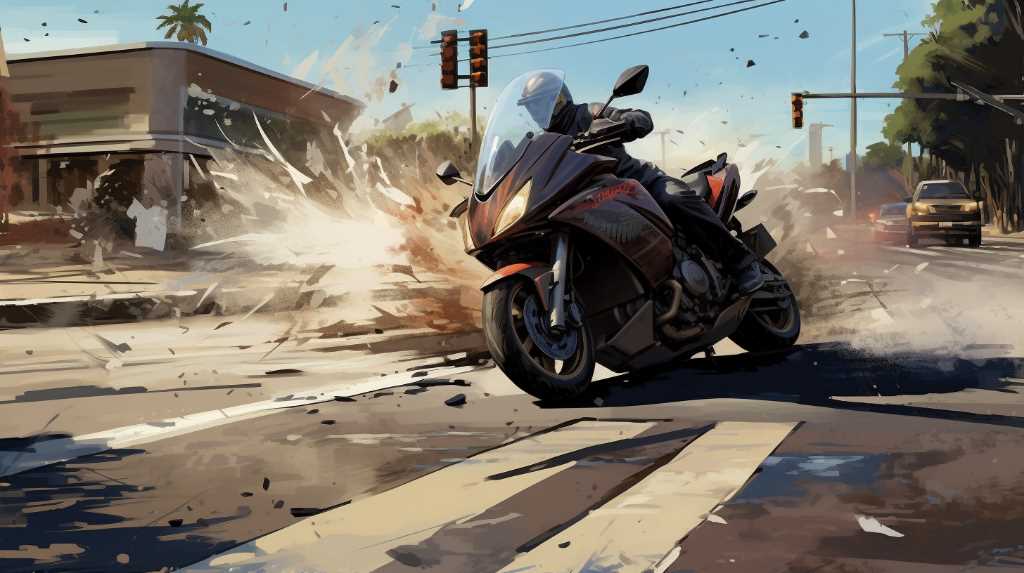
When both riders are to blame in a motorcycle crash, comparative negligence matters a lot. This rule looks at how much each person is at fault and changes the payout based on that.
If you’re dealing with insurance, they’ll pay out less money if you’re partly to blame. Figuring out who’s at fault can be tricky—it involves looking closely at what happened and what people saw.
The more you’re at fault, the more it might cost you. If you’re in an accident like this, it’s important to know what you can do and how to protect yourself. Getting a handle on this early can help you deal with who pays for what and how much you can get back after the crash.
Understanding Comparative Negligence
In many places, the rule of comparative negligence splits up the blame and costs between everyone involved in a motorcycle crash, depending on how much each person was at fault. This method is smart because it realizes that crashes can be complicated, and usually, more than one person is to blame.
By using comparative negligence, money responsibilities are shared out in a way that’s fair and matches what each person did to cause the accident. This rule encourages everyone to be careful because if they’re not, they could end up getting less money if they’re partly to blame for the accident.
Lawyers and people making claims need to understand this rule well. It helps them make smart choices and supports a legal system that looks carefully at every part of the case. It shows why it’s so important to investigate everything properly and back up your claims with evidence to make sure everyone is treated fairly.
Impact on Insurance Claims
When two people are both to blame for a motorcycle crash, figuring out who pays for what can get complicated. Insurance companies go through everything very carefully—they look at all the evidence and listen to what everyone says to decide how much each person is at fault. This part is super important because it decides how much money each person can get from the claim.
In some places, even if you’re partly to blame, you can still get money for the damage, but it’ll be less depending on how much of the accident was your fault. It’s really important to talk to the insurance company in a strong and clear way. If you don’t, they might try to pay you less by saying you were more at fault than you really were. You’ve got to show solid proof and build a strong case to make sure you get a fair amount of money that matches what actually happened.
Determining Degree of Fault
When looking into a motorcycle crash where both sides are partly to blame, it’s important to figure out how much fault lies with each person. This isn’t a guessing game. It means carefully looking at the crash site, what witnesses say, and any videos of the accident.
We also consider what the traffic laws say and how similar cases were judged before. This helps us figure out who was more careless. Sometimes, experts might even recreate the crash to get a better picture of what happened.
The result of this careful check matters a lot because it decides who has to pay for damages. When the evaluation is done right, it means everyone is treated fairly according to the local laws on negligence.
Legal Consequences Explained
In a motorcycle accident where both riders share some blame, the law in each state decides who pays for the damages. This is called comparative negligence. For example, if a state has ‘pure comparative negligence’ rules, you can still get money even if you were partly at fault, but it will be less based on how much the accident was your fault. But, in states with ‘modified comparative negligence,’ if you are more than 50 or 51 percent to blame, you won’t get any money at all.
The reason for these laws is to make sure that the costs after an accident are split fairly. Also, they encourage everyone to drive more carefully because drivers know that if they cause an accident, they might have to pay. When judges apply these laws, they are trying to make sure everyone is treated fairly in court.
Steps to Take Post-Accident
If you’re involved in a motorcycle crash where both parties are at fault, it’s really important to handle the situation carefully to protect your legal rights. First, get medical help right away, even if you think you’re not badly hurt. It’s important to have a record of your injuries for any legal action you might take later.
Next, collect evidence while you’re still at the scene. Take photos, get the contact info of any witnesses, and swap insurance information with the other person involved, but make sure you don’t say it’s your fault.
After that, you should tell your insurance company about the crash, but be careful with what you say because they might try to pay you less money. It’s really helpful to hire a lawyer who knows a lot about motorcycle crashes. They’ll understand how to deal with the tricky parts of a case where both drivers are partly to blame.
They’ll fight for you and talk to the insurance companies to make sure you get the money you deserve, and they’ll help reduce the negative impact of being partly blamed for the accident.
Conclusion
When both drivers share the blame in a motorcycle crash, the rule of comparative negligence is key. This rule decides how much money each person has to pay based on how much they were at fault.
It’s important to know how this works because it affects who is held responsible and how much they might have to pay or receive.
People involved should handle these situations carefully to make sure that the results are fair and that everyone gets the compensation they deserve.